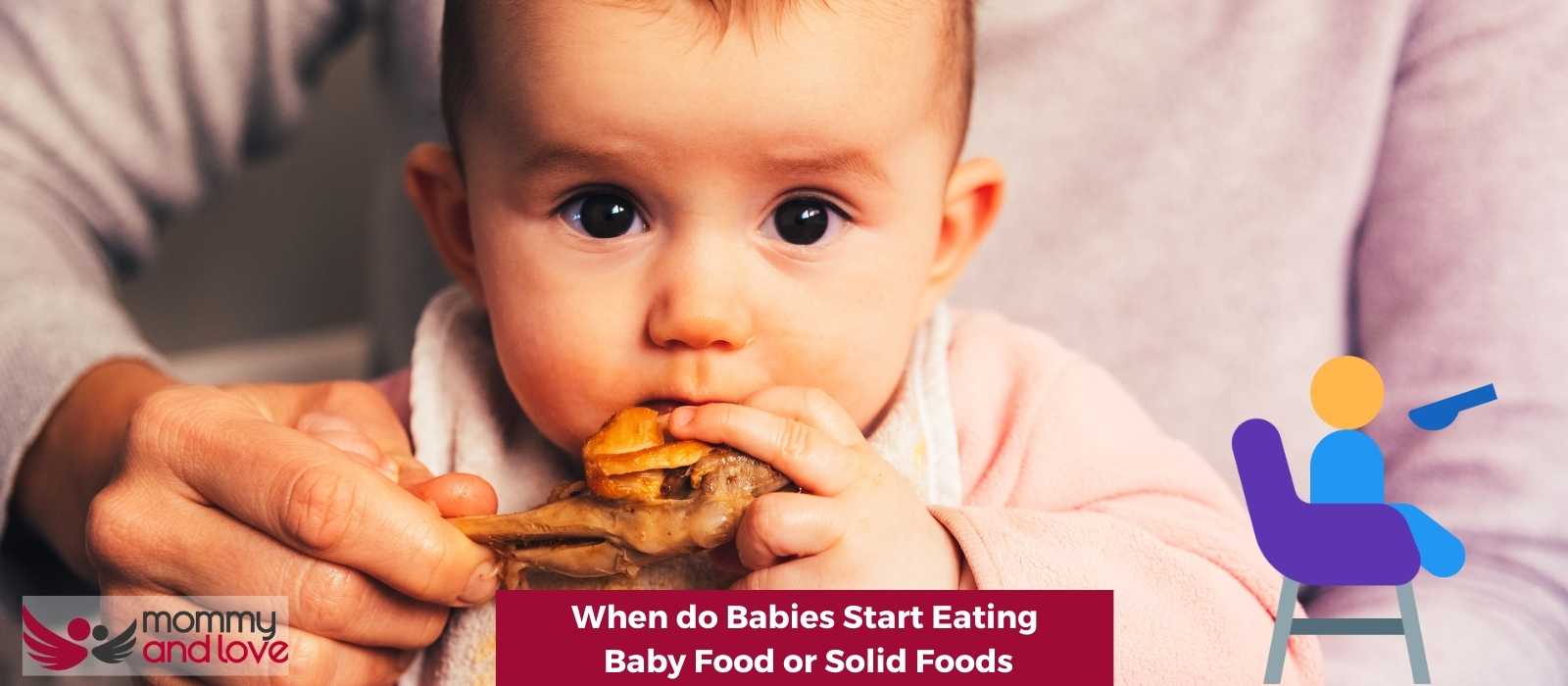When do babies start eating solid foods? This is a question that many parents have. The answer, of course, depends on the baby. Some babies are ready to start eating solid foods as early as six months old, while others may not be ready until they are eight or nine months old. In this guide, we will discuss when babies typically start eating solid foods, and we will also provide a comprehensive guide on how to introduce solid foods to your baby.
Introducing new foods to baby
According to the Dietary Guidelines for Americans and the American Academy of Pediatrics (AAP), children should be introduced to foods other than breast milk or formula when they are about six months old.
But which foods should you introduce your child to and in what order? We’ve done a guide on signs that your baby is read to wean here.
The key to introducing new foods to your child is to make sure that they are not only healthy options, but that they contain the minerals and vitamins that are so vitally important to babies and young children.
Where to start with Solid Foods

When you want to introduce solid foods, start by introducing nutrient-dense single-ingredient foods like fruits, vegetables and cereal grains (perhaps only rice cereal) between four to six months.
At this age, your infant is developmentally ready and your baby should be able to handle these new foods without choking.
Start with one food first and keep the portion small. Many parents start with iron-fortified baby cereal as a first food, if they are not doing baby led weaning. You need to decide if you are going down the spoon feeding or baby led weaning route. We’ve done a guide to baby led weaning and the benefits of baby led weaning which may help in your decision process.
Feed your baby small portions and encourage him or her to eat slowly. Half a spoonful should be enough at the beginning. Talk to your baby as you are feeding them to keep them feeling comfortable and at ease.
If your baby doesn’t like a particular food item on the first attempt, do try it again. Remember that your baby has never eaten anything thicker than formula or breast milk, so it may take quite a few attempts with a food before they are willing to eat it.
Variety is the key to proper nutrition and development, so encourage your baby to eat a range of foods from all food groups. Make sure that you include foods that are rich in iron (green vegetables, meat, fortified cereal) and zinc. You can often mix their first foods with milk (breast, formula or cow’s milk) when they start to eat solid foods.
Over a period of time, you’ll find that you’ll be able to increase the amount and variety of food and food textures your baby eats. Eventually, you’ll reach a stage when your baby can eat the same foods as the rest of the family, but in smaller portions.
First foods
It can be a good idea to start with single vegetables and fruits when they begin eating solid foods. Single foods are ideal to start with for solid food because of the risk of food allergies.
Try mashed or soft cooked sticks of parsnip, broccoli, potato, yam, sweet potato, carrot, apple or pear.
While you may be tempted to not include vegetables that are not sweet, such as broccoli, cauliflower and spinach, it’s a good idea to get your baby used to a range of flavours that aren’t sweet as this may help prevent them from being fussy eaters as they grow up.
Remember, your baby doesn’t need salt or sugar added to their food (or cooking water), so don’t go there!
How Much Food
As a guide, a baby between six and nine months can eat between one and four tablespoons of food at each meal and you should ensure that this will consist largely of fruit, vegetables and grains in purée form. This is, however, only a rough guideline and you need to remember every baby’s appetite is different.
Each new food should be the only food introduced at that time. Do not push food on the baby and fruit juice should be avoided until later. Remember, most of the baby’s nutrition will still from milk and starting solid foods is only meant to complement their milk intake initially, not over take it.
If you introduce solid foods to early, before their stomachs can digest it, there is a risk of severe eczema. If you have a history of eczema in your family, you should always consult with your child’s doctor before you start solid foods.
Foods to try:
Stage one – Six months +:
Your baby should be able to sit upright and have good head control before introducing solids and putting them into a high chair. A Baby’s growth will still come from milk and if you introduce foods at this stage, it’s just a tiny amount.
It is best to serve puréed baby foods at this stage as your baby won’t have the ability to chew their food. Start off with infant cereals or thin purées and, as your baby gets used to taking them off the spoon, you can begin to serve them a little thicker. It’s best to avoid potentially allergenic foods at this early stage in baby’s diet.
The WHO recommends leaving weaning until six months plus and babies should be kept exclusively on breast milk or infant formula until this age. Foods added should be complementary foods to milk as their main diet, just 2-3 times a day. The foods introduced should be iron rich foods.
Perfect foods for this stage include:
Puréed vegetables:
Carrot, parsnip, sweet potatoes, broccoli, butternut squash, spinach, Brussel sprouts, cauliflower, leeks, turnip, etc. It is advisable to avoid introducing the nightshade family initially, as some babies can be sensitive to these – these are potatoes, tomatoes, peppers, aubergine and courgette.
Breastfed infants can have some expressed milk added to these pureed foods whilst formula babies can add in some formula. They shouldn’t be given raw vegetables, just soft foods which have been cooked. Most babies will still get most of their nutritional needs from their milk feeds. Iron fortified cereal can be given at this stage, made with their usual milk.
Puréed fruit:

Mashed banana is usually a favourite and is extremely handy when on the go!
It is a good idea to avoid any fruit with seeds, like kiwi or raspberries to start with, and choose fruits that are easy to mash or purée instead, like banana, stewed apple, pureed pear or avocado which make perfect pureed foods.
Puréed pulses: These can be added to help satisfy a very hungry baby – again, make sure they are well mashed or puréed and use tinned pulses without added sugar or salt. Try red lentils or butter beans.
As your baby gets used to the individual flavours, you can try mixing and matching the purées to make your own little recipe combinations.
Stage two – Seven to nine months
At this stage your baby should be well used to eating from a spoon and at this stage there should be more texture in your baby’s food, but no hard lumps yet. More texture will encourage your baby to chew and this will help develop their speech muscles. Adding in some protein such as chicken, fish or beef to fruit and vegetable purees is a good way of adding texture and encouraging chewing.
Your baby may have new teeth at this stage so why not offer some carrot sticks or apple slices to gnaw at (never ever leave your baby alone whilst eating in case of choking). Again add in new foods one by one and be alert to any reactions. New research has indicated that introducing highly allergenic foods earlier is actually better to prevent food allergies. Always introduce single ingredient food and keep track of all reactions.
Allergy foods include egg allergy, cow’s milk, tree nuts and many more. We’ve done a guide to introducing allergens to babies, including when, what and how!
Foods to add in at this stage can include:
Meat: Oily fish such as salmon, tuna, Mackerel, chicken and other red meats can be added in small quantities.
Pulses: Brown lentils, haricot beans, cannellini beans, mung beans etc
Juices: Freshly made juices can be offered with meals (on their own they can promote tooth decay). Exclude citrus juices but try apple, carrot, pear, melon and others. Make sure there are no seeds or pips and dilute 50/50 with water.
Stage three – nine to twelve months
From around nine months, your baby will show a desire to feed themselves. It may get a little messy at times and a degree of patience is needed, but allow them to experiment with one spoon whilst you feed them with another. At this stage you can add in foods like hot dogs and other packaged foods like o shaped cereal.
Your baby is likely to have several teeth at this stage, and you may find that you can mash their food rather than purée it. You can now introduce more finger foods, such as mini rice cakes, pieces of chicken, chunky carrot sticks or apple slices. Again, never ever leave your baby unattended whilst eating in case of choking.
The Bottom Line on when do babies start eating real food
So when do babies start eating real food? The answer is that there isn’t a one-size-fits-all answer, as each baby develops at their own pace. However, the general guideline is to introduce solid foods around six months old, and by nine to twelve months your baby should be able to feed themselves with little help from you.

This article was written by Sandra Baker – full time writer and the mother of four amazing kids (including twins!)
She’s also a breastfeeding counselor and has spent years helping new parents learn how to care for their children. When she’s not writing or caring for her children, Sandra likes to spend time reading and taking walks with her husband.




